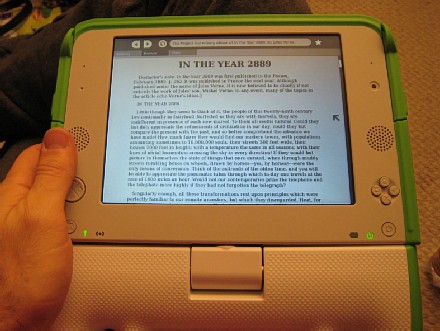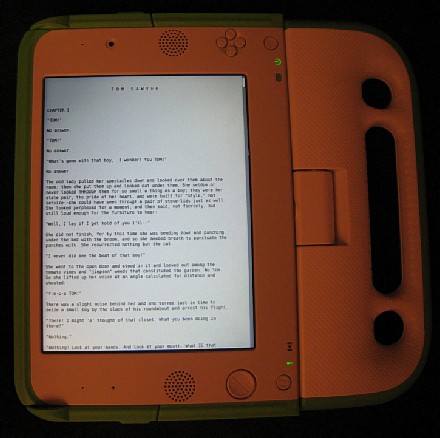Will New eBook Readers Finally Change The World?
David Rothman over at the esteemed Teleread blog has finally given his opinion of the unique screen being used by the One Laptop Per Child XO computer.
Current e-readers — Sony Reader, iLiad, Cybook, Kindle, and others from Asia — use eInk screen technology. This provides extremely low power consumption because the screen is actually off while displaying text. Power is used only during page turns.
But it’s that page turning that might be a roadblock to the widespread acceptance of dedicated e-readers: the screen momentarily “flashes” as the display controller summons the necessary pixels to form the next set of words. My initial reaction to this was negative, but I got beyond that. Could most people?
Now there’s the remarkable XO screen which, according to Rothman, does equally well in bright sunlight (as monochrome) and in darkness (mono or color; it has the backlight eInk lacks).
Here’s an example of how that XO screen would work with ebooks as well as the possible way it could change the way some ebooks are produced:
I’m no expert on how ebooks are created and formatted for screens. I leave details such as that to experts such as Rothman (who has been banging the drums for a universal ebook file format for years and years and years and whom I consider sort of my ebook mentor).
In researching this post, I had to admit that I’m late to this game. I’ve not paid much attention to the XO. But others have — and they’re proposing new e-reading devices that could cost as low as fifty dollars to manufacture.
Even pumping in a few reseller margins, that could realistically mean a e-reader for as high as US$150 or as low as US$100.
At US$100, it would be just about an impulse buy in this country. That price would remove the hesitation people feel about spending $300 (or more) on current devices. People intrigued with the thought of ebooks would no longer have to go through budgetary contortions to justify buying one.
And here is something I didn’t know: the XO screen has a higher resolution than the Asus EeePC:
Since the Eee PC’s screen is much lower resolution and a different aspect ratio, the full XO screen is distorted when set to fit.
— Flickr photo caption
And:
Part of the 1200×900 XO laptop screen viewed on the 800×480 screen of the Eee PC laptop
— Flickr photo title
Here are three examples of the XO screen as ebook reader:
Also note that current e-readers based on eInk have a resolution of only 800 x 600.
This new screen brings up interesting questions:
1) Would any current e-reader makers dump their current eInk screens for it?
2) Would Sony offer an enhanced Reader based on this screen? The lack of Search has been a sore point for some people. In Sony’s defense, I always point out it’s called the Sony Reader, not the Sony Scholar.
3) Would Apple be interested in using it for an e-reading device? Personally, I think this is highly unlikely. Look at the iPod: it’s gone from being a single-purpose (audio) to multi-purpose (music, video, games, calendar) device.
4) Would Microsoft be interested in re-entering the ebook market with an e-reader based on this screen? Personally, I think this could be likely. I’ve liked the times I got to use Microsoft Reader on my Toshiba GENIO Pocket PC.
But even these questions might be beside the point right now.
Because the lead developer of the XO screen, Mary Lou Jepsen, has left the OLPC project — to pursue a US$75 laptop.
If she were to succeed, perhaps e-readers based on her screen could fall to a US$50 — or even lower — retail price.
And that would change the world.
Explore posts in the same categories: eBooks, Tech - Microsoft, Tech - Other, Tech - Sony


January 11, 2008 at 1:16 pm
Re “I always point out it’s called the Sony Reader, not the Sony Scholar”: It drives me nuts to read a long article in let’s say WSJ and near the end see something like “This is the basis of our position” said Cane…
Now which of the dozen people mentioned in the article was Cane? Either I have to go fishing through the article for the first reference to Mr./Ms. Cane, or just do without the context of the quote and wish I were reading it on a device where I could paste “Cane” into the search box.
Ya gotta have search. I’ll choose a thing with a lousy screen and search over one with a good screen but no search anytime.
January 11, 2008 at 1:28 pm
Ah, see, that’s a non-fiction thing, I think.
For many people who read primarily fiction, this isn’t a major issue, I think.
Kindle has Search, but from all accounts it is hardly better than having no Search at all.
But yes, ideally, it is best to be able to have as many options as possible.